The Obligatory @media 2006 Write Up
It’s never easy to start something completely new. I mean huge things, like to sign up for the first trip to Mars, engage in a war against United States, or to start blogging in another language, nothing less. As I am too busy for the first two right now, I settled down for the third option.
A good motivation for the switch was the purely English event: @media 2006 Web conference in London.The conference was held in Queen Elizabeth II Conference Center on 15th and 16th June. For those who wanted to get the most of this unusual gathering of web standards geeks, there were also unofficial meetings (also known as “parties”) at Wednesday and Saturday, and after each day of the conference.
It was the first time I attended this kind of event. But I enjoyed it not only because of initial excitement. The meeting was also a great chance to listen and say hello to people like Dave Shea, Simon Willison, Cameron Adams, and many more I admire and previously knew only from their blogs. Even though it was difficult to hear something you never ever read before in the blogosphere, it’s always great to ask questions directly to the members of the web vanguard.
You could find a complete list of sessions on the conference’s website. I hope podcasts and slides will be there soon. Given that, let me focus on few selected presentations I enjoyed the most.
IE 7 and beyond
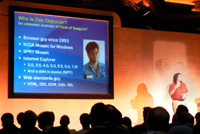
I had a really big expectations before this talk given by Chris Wilson. Chris is a Group Program Manager for Internet Explorer 7, aka The Man to Blame. If you’ve been following IEblog, there was not too much news in the Chris’ presentation: he focused on RSS related features and support for OpenSearch. The latter is a standard that allows any website to be searched directly from the browser. It is similar to custom search engines you know from Firefox, but uses XML rather than some custom markup. (Firefox 2.0 will support OpenSearch too.)
Predicting that this issue will be eventually raised, Chris mentioned the support for running IE 7 next to IE 6. He said that it wasn’t disabled intentionally, to prevent developers from testing websites in both versions of the browser simultaneously. While it’s unlikely that we’ll be able to have two fully fledged IEs on the same machine because of the browser’s strong integration with the OS, in the future we may could use both rendering engines for testing. Chris said that the Internet Exporer team is working on this. I really hope it will be possible, since now IE 7, when installed next to IE 6, requires some nasty registry hacks and eats 100% of the processing power.
Chris mentioned the highly anticipated better support for webstandards, which provoked me to ask a question about his view on the work done by
WHAT WG. (This a group of people from Apple, Mozilla and Opera who work outside of W3C on updating the HTML specification to better support developers’ needs, especially in the field of web applications). Wilson is very skeptical about these developments and the way they’re done (ie: outside of the W3C). He also claims that they may break several patents. Thus I think that it’s very unlikely that we’ll see support for canvas element or HTML 5 any time soon in IE.
The New Accessibility Guidelines: WCAG 2.0
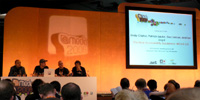
After the lunch I was listening to the panel about the new, highly criticized Web Content Accessibility Guidelines, version 2.0. The panelists, — Andy Clarke, Patrick Lauke, Gez Lemon, and Ian Lloyd — were trying to explain the thinking behind WCAG 2.0, especially the idea of being “technology agnostic”. Yet, they didn’t even try to pretend that it has anything to do with “comprehensible”. The new guidelines don’t mention specific technology which makes them general and universal. Unfortunately, they’re also abstract to the point they may become useless: if content authors won’t be able to easily understand them, how can one expect that the guidelines will be actually implemented?
There are small lights in the tunnel, though. After recent Joe’s Clark article, To Hell with WCAG 2, there is a lot of talk about new guidelines and hopefully it may cause WAI members to make guidelines more, ehm, accessible. The last call period for the spec was extended to 22th June. Personally I doubt if it will matter much. The recently formed WCAG Samurai, the group of people with deep knowledge and interest with the state of accessiblity, may come up with something much better. The panelists seemed to be looking forward for Samurai’s work. As I’m sure Samurai people will create something worth of attention, I wonder if they’ll have as much impact as W3C has. This is an important factor, since WCAG guidelines are not just some geeky specs, but also a baseline for accessibility regulations in many countries.
One of the panelists, Gez Lemon, mentioned the page I personally find very useful: WCAG 2.0 Quick Reference. The guidelines are presented there as a customizable list, along with links to related CSS and markup techniques.
Designing the Next Generation of Web Apps
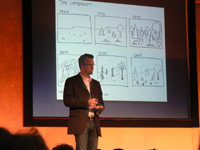
The first day ended with Jeffrey’s Veen presentation. I’ve read before that Veen is an awesome speaker, but what I saw on stage was beyond my expectations. All the sessions were recorded, so I hope that the video with his performance (the word presentation is not accurate enough) will be published somewhere. Although Jeff left no doubt that the phrase Web 2.0 is actually extremely passé now, he did his best to show what we could learn from this buzzword driven fad.
DOM Scripting: The Next Level

Next morning I enjoyed the panel led by Cameron Adams. The panelists have showed a broad spectrum of views on JavaScript libraries. PPK doesn’t use them at all, Dan Webb is very skeptical, Stuart Langridge use them to simplify tedious tasks such as Ajax scripting, and Simon Willison seemed to be the most enthusiastic about them. It’s clear that, as tempting as they might look, the libraries could easily be source of the disaster if you belive that you could use them without deep understanding of JavaScript. I think it was the main point of this session: use them, but only if you know what you’re doing.
Both Stuart and Simon were very positive and optimistic about dojo. Although this library is still in an early stage of development and needs more documentation badly, it also has a widest set of features and introduces many innovative concepts, such as compression based on real JS parsing or client-side persistent storage. The drawback is that dojo is a kitchensink now, with a lot of magic going on under the hood.
On the sidenote, it was really nice to see Simon talking very positively about dojo, even though his current employer promotes a different library now.
Internationalization: Awakening the Sleeping Giant
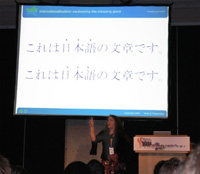
Later on I enjoyed Molly’s Holzschlag session on internationalization. Although Molly only touched the tip of the iceberg, she made a really important point: internationalization and localization are much more than translation. When creating a localized version of the website, we must think not only about particular words but also about text layout, keyboard usage, iconography and even color, as its meaning changes across different cultures. I feel obliged to note that Molly is very energetic and engaging speaker. It was a real pleasure watching and listening to her.
Microformats: Evolving The Web
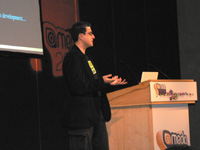
The last presentation was given by Tantek Çelik of Technorati and IE for Mac fame. Tantek is one the people behind microformats, a set of pieces of basic XHTML augmented with class attributes. The idea behind microformats is to build a publicly agreed standards for common pieces of data we used to put on the web very often, such as contact information.
In my opinion it’s much like a “Semantic Web for the poor”. The Semantic Web is a set of W3C standards, such as RDF and OWL, created to make the data easily parsable by spiders and interchangeable. Unfortunately, the Semantic Web didn’t make its way through the internet yet and I doubt if it will any time soon. Standards are complicated, the required knowledge level required to make use of them is high and most web developers never heard of the idea before, not to mention implementing this. After reading several articles on the topic on great Michał’s Świątkiewicz weblog (unfortunately it’s only in Polish now) I became enthusiastic about the idea, however I’m still very skeptical about the adoption of these standards.
Microformats aren’t as sophisticated at all. They’re build upon technology any web developer already knows — XHTML. Tantek pointed out two important things that make microformats so promising. First, they’re searchable by contemporary search robots. There’s also this “laziness factor” we should never underestimate — the Web has already shown that simple, open solutions based on existing technologies have much more chances to survive.
I asked Tantek whether he sees microformats as competitor to Semantic Web standards. He admitted this, but also pointed out that microformats could be easily transformed to RDF using XSLT. They’re pieces of well formed XML, after all. So even though personally I’d like to see a broader adoption of RDF, microformats can be a step in a good direction, too.
Hot Topics
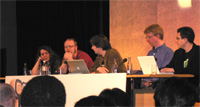
For my surprise, the ending “Hot Topics” panel turned out to be one the most engaging parts of the conference. The panelists, Molly, Jeremy, Jon, Tantek and Eric, shared their thoughts on such deep topics as “What’s your favourite furry animal?” (obviously Ewok left all the competitors behing) and “Who’ll win the World Cup?” (we should soon see for ourselves whether Eric was right, betting on New York Knicks).
There were also other, at least equally insightful, questions.
In the era of web applications, what we could learn from traditional GUI designers?
Panelists tend to agree that… not too much, since a lot of existing conventions don’t fit the web or poses unnecessary limitations. Jon pointed out that on the web users have a much more control over the interface. Users can now set up the text size or use own stylesheets.
Tantek said that one big missing feature of web apps is the lack of undo function. When present, it could eliminate the need for disturbing confirmation dialogs, which break the workflow. The Back button should carry out this role but it still doesn’t work well with current generation of web apps.
Can Ajax be made accessible?
This question caused a lot of consternation. I think that Eric phrased it in the best way: “It can be, but will be?”. In order to make Ajax really accessible, significant changes are required in browsers and screenreaders. Tests show that even sophisticated Ajax applications may work with screenreaders. On the other hand, Tantek mentioned that 15% of Technorati user’s have JavaScript disabled. It’s a huge number that shouldn’t be understated. Technorati’s Watchlist was mentioned as a good example of Ajax application that degrades nicely when JavaScript is not available.
Isn’t the massive movement of high-profile web designers to large companies like Google a little worrying?
All of the panelist don’t work for Google or Yahoo! (yet) and all of them were a bit concerned. The good thing is that the companies mentioned give out for free a lot of great services. But the problem can be that they also tend to limit the sharing of the ideas. When inside the corporate giant, web designers and developers are often limited on what they can show to the world. The obvious sign of this is that many of them blog much less now.
Jon was worried that a lot of people now start their own web ventures just to be bought by Google or Yahoo later on, instead of providing actual value to the users. Personally I’m sensing a gloomy shadow of Paul Graham here.
Summary?
Unfortunately, I didn’t attend the Saturday get-togethers, so “Hot Topics” panel was the last session for me, beside the after conference party. The conference was a great experience. I can’t wait for the next year.
qvist
thanks for this article, nice knowledge base
Wojciech Bednarski
Thanks for great link about WCAG 2.0.
Were you alone or with somebody from Poland?
Szafranek
On the conference I’ve met one other Pole, who’s teaching at University in London.
But the city seems to be invaded by Poles anyway :). During the 3 days I met about 10 people from our country.
Thomas
I am impressed Mr. Szafranek, very nice summary and link collection.
I would like to see more English on your site :-)
Szafranek
Thanks Thomas.
I switched to English on my site, so expect more to come. Someday :).